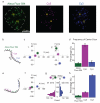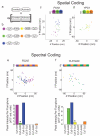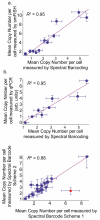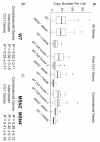Single-cell systems biology by super-resolution imaging and combinatorial labeling
- PMID: 22660740
- PMCID: PMC3418883
- DOI: 10.1038/nmeth.2069
Single-cell systems biology by super-resolution imaging and combinatorial labeling
Abstract
Fluorescence microscopy is a powerful quantitative tool for exploring regulatory networks in single cells. However, the number of molecular species that can be measured simultaneously is limited by the spectral overlap between fluorophores. Here we demonstrate a simple but general strategy to drastically increase the capacity for multiplex detection of molecules in single cells by using optical super-resolution microscopy (SRM) and combinatorial labeling. As a proof of principle, we labeled mRNAs with unique combinations of fluorophores using fluorescence in situ hybridization (FISH), and resolved the sequences and combinations of fluorophores with SRM. We measured mRNA levels of 32 genes simultaneously in single Saccharomyces cerevisiae cells. These experiments demonstrate that combinatorial labeling and super-resolution imaging of single cells is a natural approach to bring systems biology into single cells.
Figures





Comment in
-
Single-cell in situ RNA profiling by sequential hybridization.Nat Methods. 2014 Apr;11(4):360-1. doi: 10.1038/nmeth.2892. Nat Methods. 2014. PMID: 24681720 Free PMC article. No abstract available.
Similar articles
-
Turning single cells into microarrays by super-resolution barcoding.Brief Funct Genomics. 2013 Mar;12(2):75-80. doi: 10.1093/bfgp/els054. Epub 2012 Nov 22. Brief Funct Genomics. 2013. PMID: 23178478 Free PMC article. Review.
-
Single-cell in situ RNA profiling by sequential hybridization.Nat Methods. 2014 Apr;11(4):360-1. doi: 10.1038/nmeth.2892. Nat Methods. 2014. PMID: 24681720 Free PMC article. No abstract available.
-
Simultaneous Detection of mRNA and Protein in S. cerevisiae by Single-Molecule FISH and Immunofluorescence.Methods Mol Biol. 2020;2166:51-69. doi: 10.1007/978-1-0716-0712-1_4. Methods Mol Biol. 2020. PMID: 32710403
-
PALM and STORM: unlocking live-cell super-resolution.Biopolymers. 2011 May;95(5):322-31. doi: 10.1002/bip.21586. Epub 2011 Jan 19. Biopolymers. 2011. PMID: 21254001 Review.
-
Quantitative Super-Resolution Imaging of Small RNAs in Bacterial Cells.Methods Mol Biol. 2018;1737:199-212. doi: 10.1007/978-1-4939-7634-8_12. Methods Mol Biol. 2018. PMID: 29484595
Cited by
-
Turning single cells into microarrays by super-resolution barcoding.Brief Funct Genomics. 2013 Mar;12(2):75-80. doi: 10.1093/bfgp/els054. Epub 2012 Nov 22. Brief Funct Genomics. 2013. PMID: 23178478 Free PMC article. Review.
-
Localization and abundance analysis of human lncRNAs at single-cell and single-molecule resolution.Genome Biol. 2015 Jan 29;16(1):20. doi: 10.1186/s13059-015-0586-4. Genome Biol. 2015. PMID: 25630241 Free PMC article.
-
What's Luck Got to Do with It: Single Cells, Multiple Fates, and Biological Nondeterminism.Mol Cell. 2016 Jun 2;62(5):788-802. doi: 10.1016/j.molcel.2016.05.023. Mol Cell. 2016. PMID: 27259209 Free PMC article. Review.
-
Spatiotemporal strategies to identify aggressive biology in precancerous breast biopsies.WIREs Mech Dis. 2021 Mar;13(2):e1506. doi: 10.1002/wsbm.1506. Epub 2020 Oct 1. WIREs Mech Dis. 2021. PMID: 33001587 Free PMC article. Review.
-
Light microscopy applications in systems biology: opportunities and challenges.Cell Commun Signal. 2013 Apr 11;11(1):24. doi: 10.1186/1478-811X-11-24. Cell Commun Signal. 2013. PMID: 23578051 Free PMC article.
References
-
- Johnson DS, Mortazavi A, Myers RM, Wold B. Genome-wide mapping of in vivo protein-DNA interactions. Science. 2007;316:1497–502. - PubMed
-
- Mortazavi A, Williams BA, McCue K, Schaeffer L, Wold B. Mapping and quantifying mammalian transcriptomes by RNA-Seq. Nature methods. 2008;5:621–8. - PubMed
-
- Schena M, Shalon D, Davis RW, Brown PO. Quantitative Monitoring of Gene Expression Patterns with a Complementary DNA Microarray. Science. 1995;270:467–470. - PubMed
-
- Elowitz MB, Leibler S. A synthetic oscillatory network of transcriptional regulators. Nature. 2000;403:335–8. - PubMed
Publication types
MeSH terms
Substances
Grants and funding
LinkOut - more resources
Full Text Sources
Other Literature Sources
Molecular Biology Databases
Research Materials

